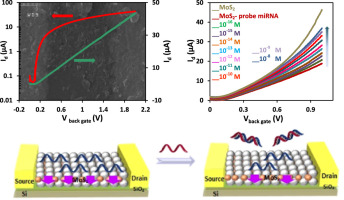Biosensors and Bioelectronics ( IF 10.7 ) Pub Date : 2018-01-06 , DOI: 10.1016/j.bios.2018.01.009 Samira Mansouri Majd , Abdollah Salimi , Foad Ghasemi

|
MicroRNAs (miRNAs), critical biomarkers of acute and chronic diseases, play key regulatory roles in many biological processes. As a result, robust assay platforms to enable an accurate and efficient detection of low-level miRNAs in complex biological samples are of great significance. In this work, a label-free and direct hybridization assay using molybdenum disulfide (MoS2) field-effect transistor (FET) biosensor has been developed for ultrasensitive detection of miRNA-155 as a breast cancer biomarker in human serum and cell-line samples. MoS2, the novel 2D layered material with excellent physical and chemical properties, was prepared through sequential solvent exchange method and was used as an active channel material. MoS2 was comprehensively characterized by spectroscopic and microscopic methods and it was applied for fabrication of FET device by drop-casting MoS2 flacks suspension onto the FET surface. MoS2 FET device showed a relatively low subthreshold swing of 48.10 mV/decade and a high mobility of 1.98 × 103 cm2 V−1 s−1. Subsequently, probe miRNA-155 strands were immobilized on the surface of the MoS2 FET device. Under optimized conditions detection limit of 0.03 fM and concentration range 0.1 fM to 10 nM were achieved. The developed biosensor not only was capable to identification of fully matched versus one-base mismatch miRNA-155 sequence, but also it could detect target miRNA-155 in spiked real human serum and extracts from human breast cancer cell-line samples. This approach paves a way for label-free, early detection of miRNA as a biomarker in cancer diagnostics with very high sensitivity and good specificity, thus offering a significant potential for clinical application.
中文翻译:

通过使用二维二硫化钼场效应晶体管生物传感器的直接杂交测定法对乳腺癌中的miRNA-155进行超灵敏检测
MicroRNA(miRNA)是急性和慢性疾病的关键生物标志物,在许多生物过程中均起着关键的调节作用。因此,强大的测定平台对准确,高效地检测复杂生物样品中的低水平miRNA具有重要意义。在这项工作中,已开发出使用二硫化钼(MoS 2)场效应晶体管(FET)生物传感器的无标记直接杂交测定法,用于超敏感检测miRNA-155作为人血清和细胞系样品中的乳腺癌生物标记物。通过顺序溶剂交换法制备了具有优异的物理和化学性能的新型二维层状材料MoS 2,并将其用作活性通道材料。硫化钼2通过分光镜和显微镜方法对其进行了全面表征,并通过将MoS 2鳞片悬浮液滴铸到FET表面上,将其用于FET器件的制造。MoS 2 FET器件显示出相对较低的亚阈值摆幅(48.10 mV /十倍)和高迁移率(1.98×10 3 cm 2 V -1 s -1)。随后,将探针miRNA-155链固定在MoS 2的表面上FET装置。在最佳条件下,检测极限为0.03 fM,浓度范围为0.1 fM至10 nM。先进的生物传感器不仅能够识别完全匹配的与一碱基错配的miRNA-155序列,而且还可以检测加标的真实人血清和人乳腺癌细胞系样品提取物中的靶标miRNA-155。这种方法为癌症诊断中的生物标记物miRNA的无标记早期检测铺平了道路,具有很高的灵敏度和良好的特异性,因此为临床应用提供了巨大的潜力。










































 京公网安备 11010802027423号
京公网安备 11010802027423号